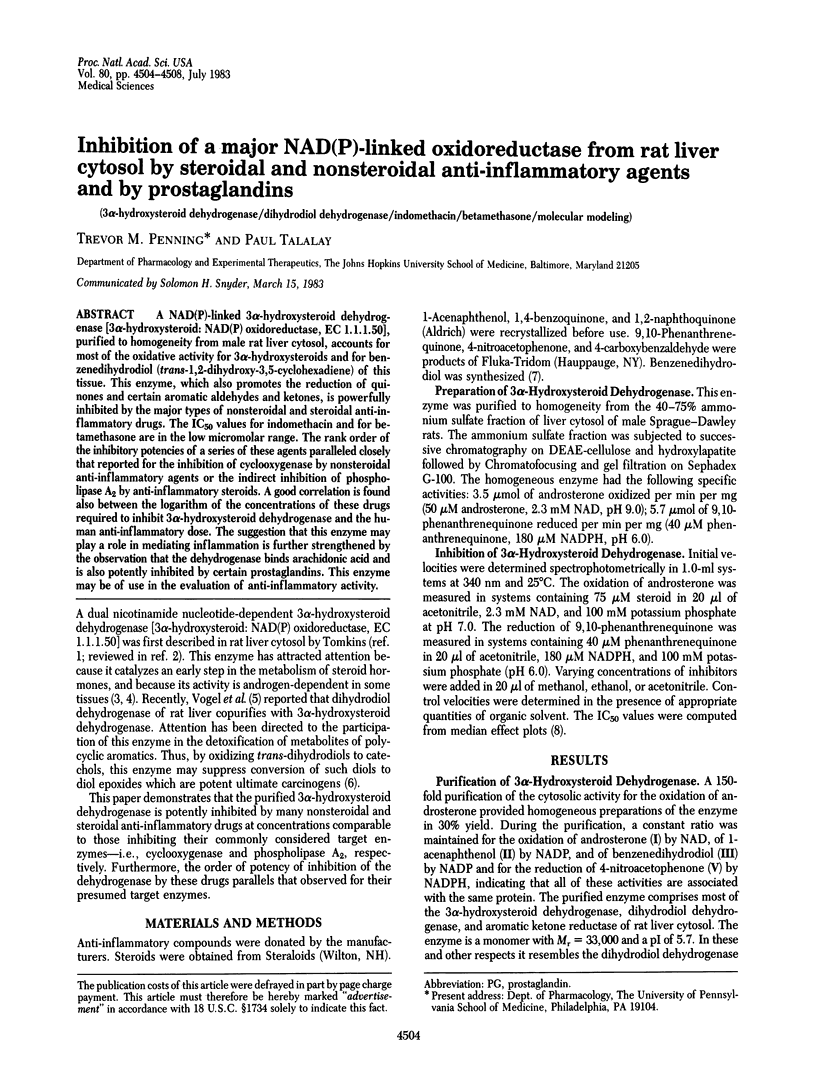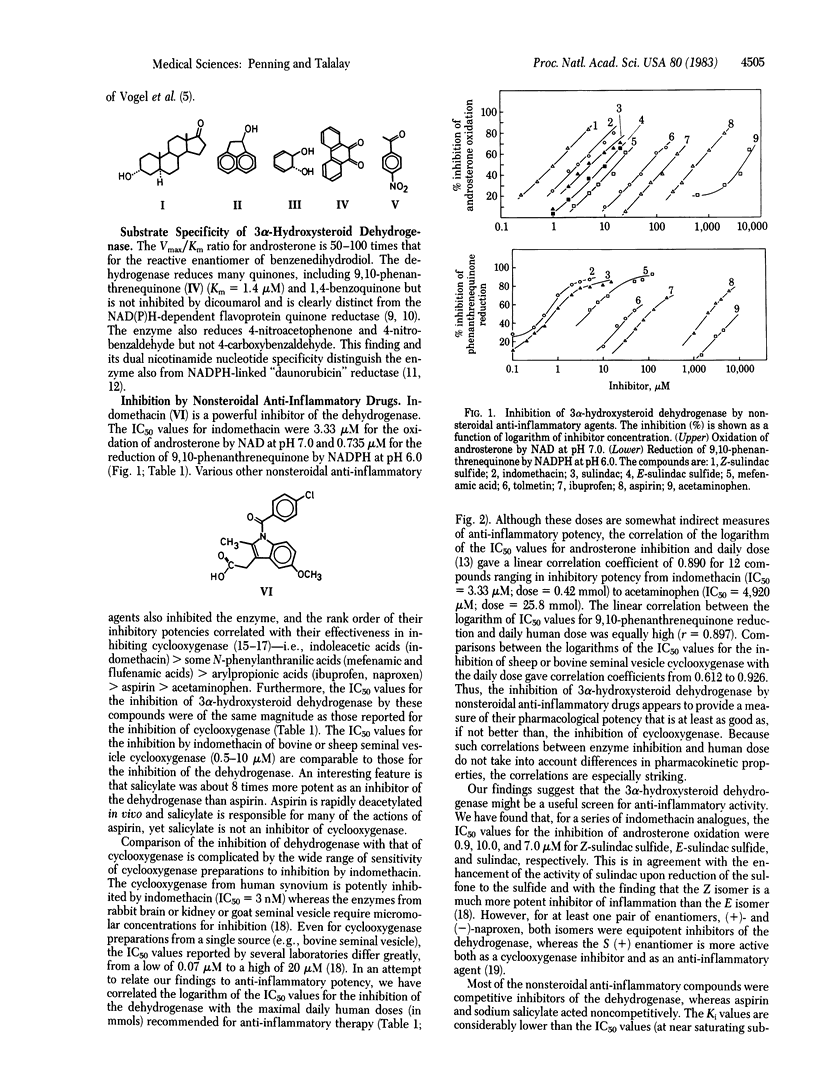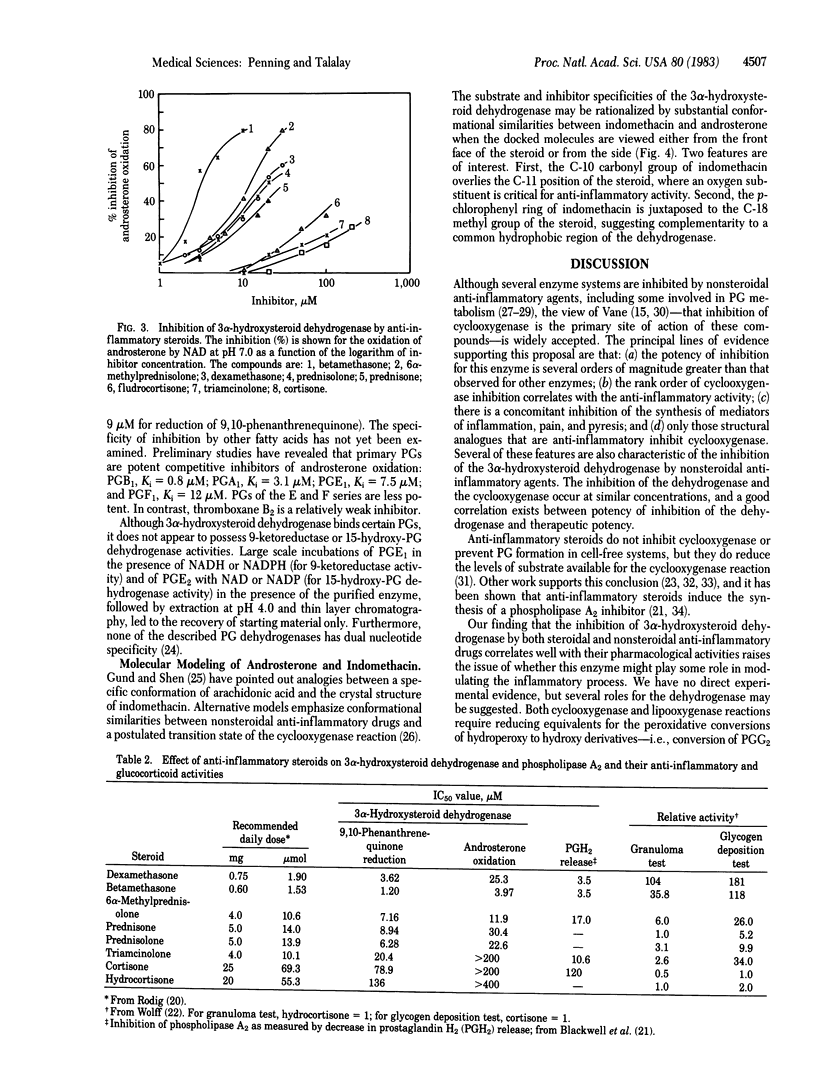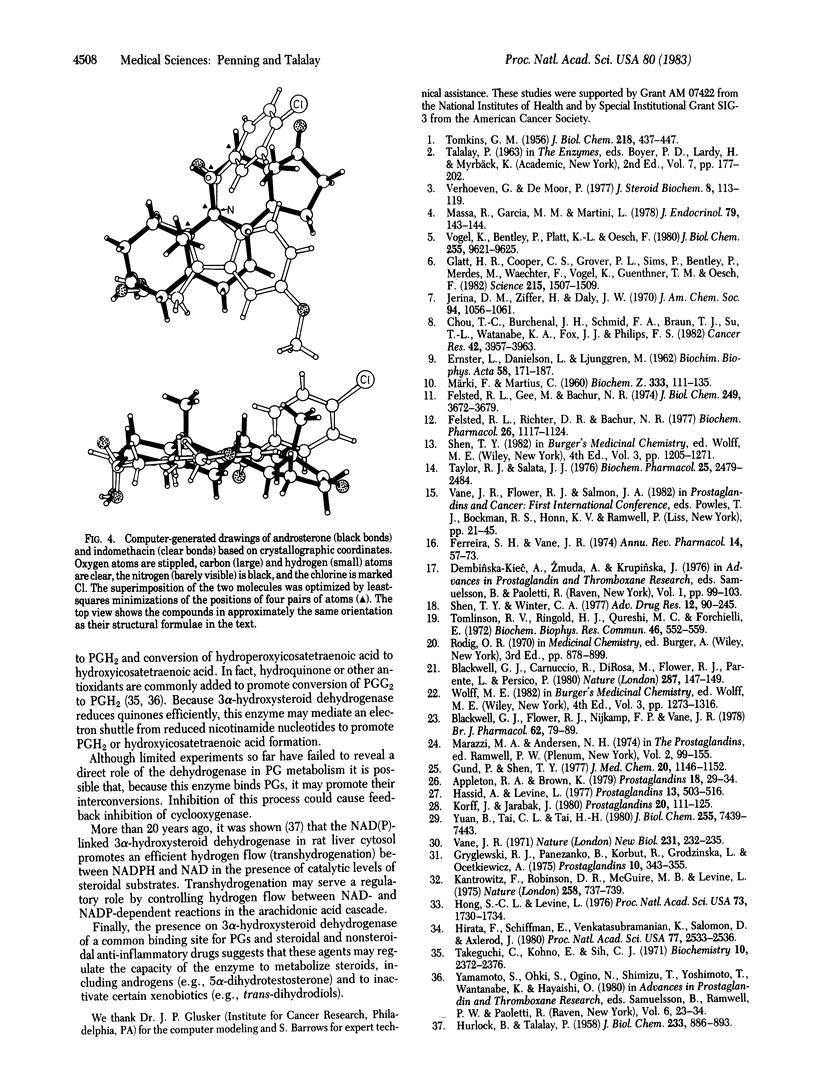Abstract
A NAD(P)-linked 3 alpha-hydroxysteroid dehydrogenase [3 alpha-hydroxysteroid: NAD(P) oxidoreductase, EC 1.1.1.50], purified to homogeneity from male rat liver cytosol, accounts for most of the oxidative activity for 3 alpha-hydroxysteroids and for benzenedihydrodiol (trans-1,2-dihydroxy-3,5-cyclohexadiene) of this tissue. This enzyme, which also promotes the reduction of quinones and certain aromatic aldehydes and ketones, is powerfully inhibited by the major types of nonsteroidal and steroidal anti-inflammatory drugs. The IC50 values for indomethacin and for betamethasone are in the low micromolar range. The rank order of the inhibitory potencies of a series of these agents paralleled closely that reported for the inhibition of cyclooxygenase by nonsteroidal anti-inflammatory agents or the indirect inhibition of phospholipase A2 by anti-inflammatory steroids. A good correlation is found also between the logarithm of the concentrations of these drugs required to inhibit 3 alpha-hydroxysteroid dehydrogenase and the human anti-inflammatory dose. The suggestion that this enzyme may play a role in mediating inflammation is further strengthened by the observation that the dehydrogenase binds arachidonic acid and is also potentially inhibited by certain prostaglandins. This enzyme may be of use in the evaluation of anti-inflammatory activity.
Full text
PDF




Selected References
These references are in PubMed. This may not be the complete list of references from this article.
- Appleton R. A., Brown K. Conformational requirements at the prostaglandin cyclooxygenase receptor site: a template for designing non-steroidal anti-inflammatory drugs. Prostaglandins. 1979 Jul;18(1):29–34. doi: 10.1016/s0090-6980(79)80020-9. [DOI] [PubMed] [Google Scholar]
- Blackwell G. J., Carnuccio R., Di Rosa M., Flower R. J., Parente L., Persico P. Macrocortin: a polypeptide causing the anti-phospholipase effect of glucocorticoids. Nature. 1980 Sep 11;287(5778):147–149. doi: 10.1038/287147a0. [DOI] [PubMed] [Google Scholar]
- Blackwell G. J., Flower R. J., Nijkamp F. P., Vane J. R. Phospholipase A2 activity of guinea-pig isolated perfused lungs: stimulation, and inhibition by anti-inflammatory steroids. Br J Pharmacol. 1978 Jan;62(1):79–89. doi: 10.1111/j.1476-5381.1978.tb07009.x. [DOI] [PMC free article] [PubMed] [Google Scholar]
- Chou T. C., Burchenal J. H., Schmid F. A., Braun T. J., Su T. L., Watanabe K. A., Fox J. J., Philips F. S. Biochemical effects of 2'-fluoro-5-methyl-1-beta-D-arabinofuranosyluracil and 2'-fluoro-5-iodo-1-beta-D-arabinofuranosylcytosine in mouse leukemic cells sensitive and resistant to 1-beta-D-arabinofuranosylcytosine. Cancer Res. 1982 Oct;42(10):3957–3963. [PubMed] [Google Scholar]
- Dembinska-Kieĉ A., Zmuda A., Krupinska J. Inhibition of prostaglandin synthetase by aspirin-like drugs in different microsomal preparations. Adv Prostaglandin Thromboxane Res. 1976;1:99–103. [PubMed] [Google Scholar]
- ERNSTER L., DANIELSON L., LJUNGGREN M. DT diaphorase. I. Purification from the soluble fraction of rat-liver cytoplasm, and properties. Biochim Biophys Acta. 1962 Apr 9;58:171–188. doi: 10.1016/0006-3002(62)90997-6. [DOI] [PubMed] [Google Scholar]
- Felsted R. L., Gee M., Bachur N. R. Rat liver daunorubicin reductase. An aldo-keto reductase. J Biol Chem. 1974 Jun 25;249(12):3672–3679. [PubMed] [Google Scholar]
- Felsted R. L., Richter D. R., Bachur N. R. Rat liver aldehyde reductase. Biochem Pharmacol. 1977 Jun 15;26(12):1117–1124. doi: 10.1016/0006-2952(77)90054-5. [DOI] [PubMed] [Google Scholar]
- Glatt H. R., Cooper C. S., Grover P. L., Sims P., Bentley P., Merdes M., Waechter F., Vogel K., Guenthner T. M., Oesch F. Inactivation of a diol epoxide by dihydrodiol dehydrogenase but not by two epoxide hydrolases. Science. 1982 Mar 19;215(4539):1507–1509. doi: 10.1126/science.7038877. [DOI] [PubMed] [Google Scholar]
- Gryglewski R. J., Panczenko B., Korbut R., Grodzinska L., Ocetkiewicz A. Corticosteroids inhibit prostaglandin release from perfused mesenteric blood vessels of rabbit and from perfused lungs of sensitized guinea pig. Prostaglandins. 1975 Aug;10(2):343–355. doi: 10.1016/0090-6980(75)90053-2. [DOI] [PubMed] [Google Scholar]
- Gund P., Shen T. Y. A model for the prostaglandin synthetase cyclooxygenation site and its inhibition by antiinflammatory arylacetic acids. J Med Chem. 1977 Sep;20(9):1146–1152. doi: 10.1021/jm00219a007. [DOI] [PubMed] [Google Scholar]
- HURLOCK B., TALALAY P. 3 alpha-Hydroxysteroids as coenzymes of hydrogen transfer between di- and triphosphopyridine nucleotides. J Biol Chem. 1958 Oct;233(4):886–893. [PubMed] [Google Scholar]
- Hassid A., Levine L. Multiple molecular forms of prostaglandin 15-hydroxydehydrogenase and 9-ketoreductase in chicken kidney. Prostaglandins. 1977 Mar;13(3):503–516. doi: 10.1016/0090-6980(77)90028-4. [DOI] [PubMed] [Google Scholar]
- Hirata F., Schiffmann E., Venkatasubramanian K., Salomon D., Axelrod J. A phospholipase A2 inhibitory protein in rabbit neutrophils induced by glucocorticoids. Proc Natl Acad Sci U S A. 1980 May;77(5):2533–2536. doi: 10.1073/pnas.77.5.2533. [DOI] [PMC free article] [PubMed] [Google Scholar]
- Hong S. L., Levine L. Inhibition of arachidonic acid release from cells as the biochemical action of anti-inflammatory corticosteroids. Proc Natl Acad Sci U S A. 1976 May;73(5):1730–1734. doi: 10.1073/pnas.73.5.1730. [DOI] [PMC free article] [PubMed] [Google Scholar]
- Kantrowitz F., Robinson D. R., McGuire M. B., Levine L. Corticosteroids inhibit prostaglandin production by rheumatiod synovia. Nature. 1975 Dec 25;258(5537):737–739. doi: 10.1038/258737a0. [DOI] [PubMed] [Google Scholar]
- Korff J., Jarabak J. Partial isolation and characterization of the 15-hydroxyprostaglandin dehydrogenases and 9-ketoprostaglandin reductases in rabbit kidney. Prostaglandins. 1980 Jul;20(1):111–125. doi: 10.1016/0090-6980(80)90011-8. [DOI] [PubMed] [Google Scholar]
- MAERKI F., MARTIUS C. [Vitamin K reductase, preparation and properties]. Biochem Z. 1960;333:111–135. [PubMed] [Google Scholar]
- Massa R., Mas Garcia M., Martini L. Androgen dependence of rat prostatic 3alpha-hydroxysteroid dehydrogenase. J Endocrinol. 1978 Oct;79(1):143–144. doi: 10.1677/joe.0.0790143. [DOI] [PubMed] [Google Scholar]
- Shen T. Y., Winter C. A. Chemical and biological studies on indomethacin, sulindac and their analogs. Adv Drug Res. 1977;12:90–245. [PubMed] [Google Scholar]
- TOMKINS G. M. A mammalian 3alpha-hydroxysteroid dehydrogenase. J Biol Chem. 1956 Jan;218(1):437–447. [PubMed] [Google Scholar]
- Takeguchi C., Kono E., Sih C. J. Mechanism of prostaglandin biosynthesis. I. Characterization and assay of bovine prostaglandin synthetase. Biochemistry. 1971 Jun 8;10(12):2372–2376. doi: 10.1021/bi00788a030. [DOI] [PubMed] [Google Scholar]
- Taylor R. J., Jr, Salata J. J. Inhibition of prostaglandin synthetase by tolmetin (Tolectin, McN-2559), a new non-steroidal anti-inflammatory agent. Biochem Pharmacol. 1976 Nov 15;25(22):2479–2484. doi: 10.1016/0006-2952(76)90452-4. [DOI] [PubMed] [Google Scholar]
- Tomlinson R. V., Ringold H. J. Relationship between inhibition of prostaglandin synthesis and drug efficacy: support for the current theory on mode of action of aspirin-like drugs. Biochem Biophys Res Commun. 1972 Jan 31;46(2):552–559. doi: 10.1016/s0006-291x(72)80174-8. [DOI] [PubMed] [Google Scholar]
- Vane J. R. Inhibition of prostaglandin synthesis as a mechanism of action for aspirin-like drugs. Nat New Biol. 1971 Jun 23;231(25):232–235. doi: 10.1038/newbio231232a0. [DOI] [PubMed] [Google Scholar]
- Verhoeven G., De Moor P. Androgenic control of themicrosomal 3alpha-hydroxysteroid oxidoreductases in rat kindey. J Steroid Biochem. 1977 Feb;8(2):113–119. doi: 10.1016/0022-4731(77)90033-4. [DOI] [PubMed] [Google Scholar]
- Vogel K., Bentley P., Platt K. L., Oesch F. Rat liver cytoplasmic dihydrodiol dehydrogenase. Purification to apparent homogeneity and properties. J Biol Chem. 1980 Oct 25;255(20):9621–9625. [PubMed] [Google Scholar]
- Yuan B., Tai C. L., Tai H. H. 9-Hydroxyprostaglandin dehydrogenase from rat kidney. Purification to homogeneity and partial characterization. J Biol Chem. 1980 Aug 10;255(15):7439–7443. [PubMed] [Google Scholar]


